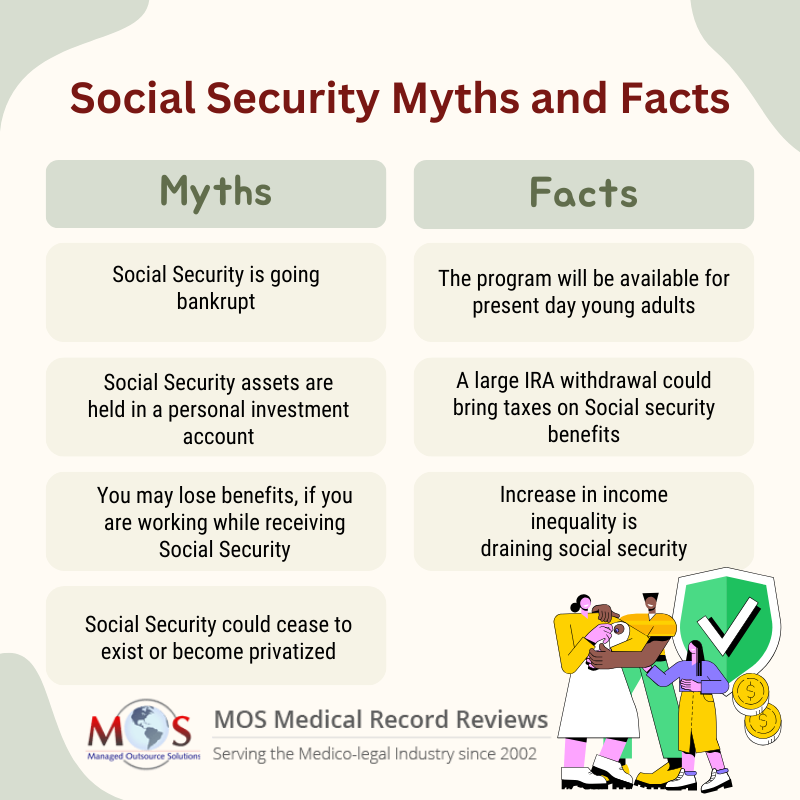The largest social welfare program in the US, Social Security benefits account for 37% of government expenditure and 7% of GDP. Its disability benefits are paid to people who cannot work because of a medical condition that is expected to last at least a year, or result in death. Applicants have the right to representation by an attorney or other qualified person of their choice when they do business with Social Security. Disability attorneys, usually with the help of medical review services provided by medical record review companies, determine whether the applicant is eligible for benefits before filing the claim. This is important because the applicant’s condition must meet the very strict definition of disability laid down by federal law. Social Security does not pay money to people with short-term or partial disability.
Are you considering outsourcing your medical record review needs?
7 Social Security Myths and Facts to Consider
The nagging concern Americans have now is regarding the possible solvency of Social Security. Let us examine some myths and facts surrounding US social security.
- Social Security is going bankrupt – This is a myth. The administration has enough money to pay retirement benefits for many decades even if urgent reforms are not made. The program may not however, have the means to meet all its planned obligations. Social Security’s income mainly comes from the 12.4% payroll tax that is split equally by employees and employers. The worker’s part is deducted from each paycheck. People who are self-employed will have to pay the full amount, minus a deduction for paying self-employment tax. Another source of revenue is the investment income and taxes paid by retirees and others on their benefits. Since the tax revenue and other income will fuel the program for the future, Social Security will still be able to pay the retirement and disability benefits. However, the retirement benefits could be reduced by 25% if the current situation continues.
- The program will be available for present day young adults – This is a fact. This welfare program will continue unless Congress takes it apart, which is highly unlikely.
- Your Social Security assets are held in a personal investment account – This is false. A 2014 Pew survey found that at least 1/3rd of Americans believe that they have dedicated social security accounts. Social Security is not an investment fund, but rather a pay-as-you-go system that transfers money from workers to retired persons.
- Social security benefits may be taxable if one takes a large IRA withdrawal – True. However, if Social Security is one’s only source of income, the benefits may not be taxable. In the presence of other income, some of the benefits may be taxable. For instance, people who have saved using a traditional IRA could get hurt by mandatory withdrawals, which start after the investor reaches age 70 ½.
- One may lose benefits, if he/she is working while receiving Social Security – Not entirely true. If one is below full retirement age (FRA) (for people presently employed, this is between age 66 or 67) some benefits may be reduced. The amount deducted depends on one’s age and earnings. If one remains below FRA throughout the year for 2016, the SSA will deduct one dollar in benefits for each $2 earned above $15,720. If one reaches FRA during 2016, the SSA will deduct one dollar for every three dollars earned above $41,880. But these benefits are only delayed, not lost. After one reaches full retirement age, the benefits will increase to make up for amounts withheld earlier. Once one reaches full retirement age, he/she can keep all the benefits, even if they are still working.
- A number of baby boomers are retiring, which could lead to draining of Social Security – This is not entirely true. Social Security may be able to pay only about three quarters of benefits by 2034, but that situation is brought about mainly by the increase in income inequality since the 1990s. The Social Security program was designed with a maximum taxable wage base which in 2024 is $168,600. Typically, the cap amount ensured that ninety percent of average wages were captured and taxed. The tax amount along with other income sources was used to cover benefits. Over the past 30 years, salaries have increased and led to more income earned above the taxable wage base. At present, only 82% of the average wages is captured. In other words, though the program has witnessed more expenditure, less money has been paid into the trust funds.
- Social Security could cease to exist or be privatized if no effective solutions are found – This is not likely. Given the popularity of the program, policymakers are considering effective solutions such as increasing the full retirement age from 67 for those born in 1960 or later, to 68 or 69; increasing the social security payroll tax; and eliminating the taxable wage cap and allowing a wider range of wages.
MOS Medical record Reviews provides dedicated medical review services for social security disability lawyers.





